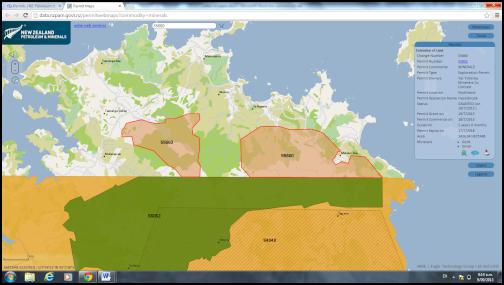Secret Mineral Exploration Permits in Whangaroa
Secret Mineral Exploration Permits in Whangaroa
Kaeo, Wednesday 11 September 2013: On 13 June 2013 the Government formally announced mineral exploration permits for Northland. This followed the unconsented aerial survey of nearly all land in the north for minerals that cost $2 million of public money.
This is the map the Government released on 13 June 2013:
It shows two exploration permits 55052 and 55053 - both within the catchments of Whangaroa Harbour awarded to Tai Tokerau Minerals Ltd, a company that Far North Mayor Wayne Brown is a director of. He also has a five percent shareholding in the company that was set up while Mr Brown has been the self-appointed cheerleader of exploration and toxic mining across Northland while being paid with public money as the chairman of the Explore Northland Minerals Group. He has been to Canada twice to tell international mining companies that Northland can't wait to have them.
According to the Government department website NZ Petroleum and Minerals, these permits were granted on 19/7/2013.
What the public wasn't told is that an "Extension of Land" to this permit area (permit number 55660) was also granted the same day, according to maps updated by NZ Petroleum and Minerals recently. These two new areas are directly behind Matauri Bay and Te Ngaere Bay and also Tauranga Valley and Matangirau.

Click for big version.
Maori and conversation interests are unimpressed with the whole situation.
“Here’s a Mayor that does not pay rates on his home but has used heaps of public money to get his own personal mining business established”, says Bryce Smith of Te Wakameninga o ngā hapū Ngāpuhi. “If the exploration led to mining then we’d have huge amounts of toxic waste between Kaeo and Matauri Bay in an extremely flood prone area. You don’t need to be a genius to see that’s not very bright.”
“The rest of the developed world is over populated and often filthy. Our huge advantage is in looking after what we’ve got and having sustainable industries, not turning Northland into industrial China,” he said.
He says the new mineral exploration licence extensions that the public didn’t know about, turns us away from a sustainable future and aims to lock us into having toxic waste dumps for short term mining.
“All Northland exploration permits should never have been given out. And the two new areas kept secret, betrays public trust even more and shows Wayne Brown is using public money to feather his own nest while putting us at risk.”
“The sustainable gold of the north is in extracting pure gold honey”, said Dean Baigent-Mercer, Chairperson of the Far North Branch of Forest and Bird. “Self-employed beekeepers earn far more than the average mine worker. Beekeeping is a sustainable income and we’re not left with a mess after a few years, like every other industrial gold and silver mine in the North Island has done”.
“It’s really tricky to remove gold that is trapped in the volcanic rocks of Northland. The rocks must be crushed to dust then mixed with cyanide and water. This reaction brings out gold and silver, but it also frees heavy metals like cadmium, mercury and arsenic. So instead of being safely trapped in the rock, mercury and other heavy metals can be taken up by plants and animals. This toxic waste needs to be stored out of the food chain beyond timescales we can imagine. It is usually stored in giant dams near to the mine itself to cut down on transportation costs”, he said.
Conservatively, 18 tonnes of toxic waste is produced to make one gold ring. 40 million tonnes of toxic waste produced from the gold mine near Waihi is stored in huge lakes near the town.
“This toxic waste must be kept out of all waterways and the food chain forever. When the companies leave or go broke we’d be left to look after it,” said Mr Baigent-Mercer. “Why would you want to store toxic waste in flood prone areas in the hills above a town, homes, agricultural areas, and major tourist attractions like Matauri Bay and the Rainbow Warrior?”
ENDS


 Gordon Campbell: On unemployment, Winston Peters’ low boiling point and music criticism
Gordon Campbell: On unemployment, Winston Peters’ low boiling point and music criticism Labour Party: National Gaslights Women Fighting For Equal Pay
Labour Party: National Gaslights Women Fighting For Equal Pay The Treasury: New Treasury Paper On The Productivity Slowdown
The Treasury: New Treasury Paper On The Productivity Slowdown NZ Government: Government Recommits To Equal Pay
NZ Government: Government Recommits To Equal Pay Emily Ireland - Local Democracy Reporter: Deputy Mayor ‘disgusted’ By Response To Georgina Beyer Sculpture
Emily Ireland - Local Democracy Reporter: Deputy Mayor ‘disgusted’ By Response To Georgina Beyer Sculpture Te Pāti Māori: Māori Unemployment Rate Increases By More Than Four-Times National Rates
Te Pāti Māori: Māori Unemployment Rate Increases By More Than Four-Times National Rates Government: Streamlining Building Consent Changes
Government: Streamlining Building Consent Changes


